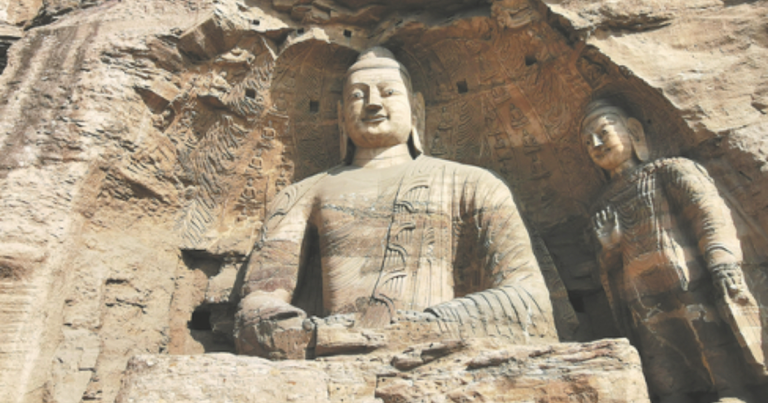
Carved in Stone: The Spiritual and Artistic Legacy of China’s Yungang Grottoes
Beijing — Nestled into the rugged cliffs of Wuzhou Mountain, just 16 kilometers west of Datong in Shanxi province, the Yungang Grottoes stand as one of the most extraordinary achievements of Buddhist art in human history.
With 252 caves and over 51,000 statues carved into 18,000 square meters of rock, this UNESCO World Heritage Site is a silent yet profound testament to the devotion and skill of artisans from the Northern Wei Dynasty (386–534 C.E.).
A Monument of Faith and Power
Commissioned by the devout Buddhist rulers of the Northern Wei Dynasty, the Yungang Grottoes were more than just an artistic endeavor—they were a political and spiritual statement. The dynasty, originally of Xianbei nomadic origin, sought to legitimize its rule by adopting Buddhism as a unifying force.
The caves, particularly the Five Caves masterminded by the monk Tan Yao, reflect a harmonious blend of Indian, Central Asian, and Chinese artistic traditions.
Each statue, from the towering 17-meter Buddha in Cave 20 to the intricate bodhisattvas lining the walls, was designed to inspire awe and reverence. The sheer scale of the project speaks to the dynasty’s ambition—transforming a mountainside into a sacred sanctuary.
The Artistic Evolution of a Sacred Space
The Yungang Grottoes are not a monolithic work but a living record of stylistic evolution. Early caves (Caves 16–20) feature robust, Gandharan-inspired figures with sharp facial features and flowing robes, reflecting strong Central Asian influences. Later caves (after 465 C.E.) show a shift toward Chinese aesthetics, with softer, more elongated figures draped in traditional Han-style garments.
This transition mirrors the Northern Wei Dynasty’s gradual assimilation into Chinese culture, culminating in their move to Luoyang and the construction of the Longmen Grottoes. Yet, Yungang remains the pinnacle of early Chinese Buddhist art, a bridge between foreign influence and indigenous expression.
Preservation Challenges in the Modern Era
Despite surviving over 1,500 years, the Yungang Grottoes face modern threats. Pollution from nearby Datong’s coal industry, natural erosion, and past mismanagement have taken a toll. In recent decades, Chinese conservators and international experts have collaborated to stabilize the site, using advanced techniques like 3D scanning and laser cleaning.
UNESCO’s designation in 2001 brought global attention, but the balance between tourism and preservation remains delicate. Authorities have restricted access to some caves, ensuring that future generations can witness this masterpiece of religious art.
A Pilgrimage for Art and Soul
Today, visitors from around the world walk the same paths as ancient pilgrims, gazing up at the serene faces of Buddhas and bodhisattvas. The Yungang Grottoes are more than a tourist attraction—they are a meditation on impermanence and devotion, where stone whispers the prayers of a bygone era.
As Dr. Li Jian, a leading scholar of Buddhist art, observes: “These caves are not just relics. They are a dialogue between earth and eternity.”
How to Get to the Yungang Grottoes from Beijing
Traveling from Beijing to the Yungang Grottoes is a straightforward journey, taking roughly 4–5 hours by high-speed rail or 6–7 hours by car. The most efficient option is the bullet train from Beijing North Station or Qinghe Station to Datong South Station, with a travel time of about 2.5 hours.
From Datong South, the grottoes are a 30-minute taxi ride (approximately 16 km west of the city). Alternatively, direct flights from Beijing Capital International Airport (PEK) to Datong Yungang Airport (DAT) take around 1 hour, followed by a 40-minute drive to the site.
For those preferring a guided experience, tour companies in Beijing offer day trips, combining visits to the grottoes with other Datong landmarks, such as the Hanging Temple or Nine Dragon Screen. Whether by rail, air, or road, the trip rewards travelers with an unforgettable encounter with China’s ancient Buddhist heritage.

For an audio summary
The Yungang Grottoes, a UNESCO World Heritage Site in Shanxi province, China, are a breathtaking ensemble of 252 caves and 51,000 Buddhist statues carved into a mountainside during the 5th and 6th centuries. A fusion of Indian, Central Asian, and Chinese artistry, they reflect the Northern Wei Dynasty’s spiritual ambitions. Today, preservation efforts combat erosion and pollution, ensuring this sacred masterpiece endures.